Home / Conformational Isomers of Propane
Conformations and Cycloalkanes
Conformational Isomers of Propane
Last updated: November 21st, 2024 |
The Conformational Isomers of Propane (Are Awesome)
In this post we’ll explore the different conformations of propane and see that it has a slightly higher barrier to rotation than ethane due to a new steric interaction. We’ll draw out the Newman projection of propane from multiple perspectives, show the different Newman projections as we rotate through 360° , and map out the energy diagram vs dihedral angle!
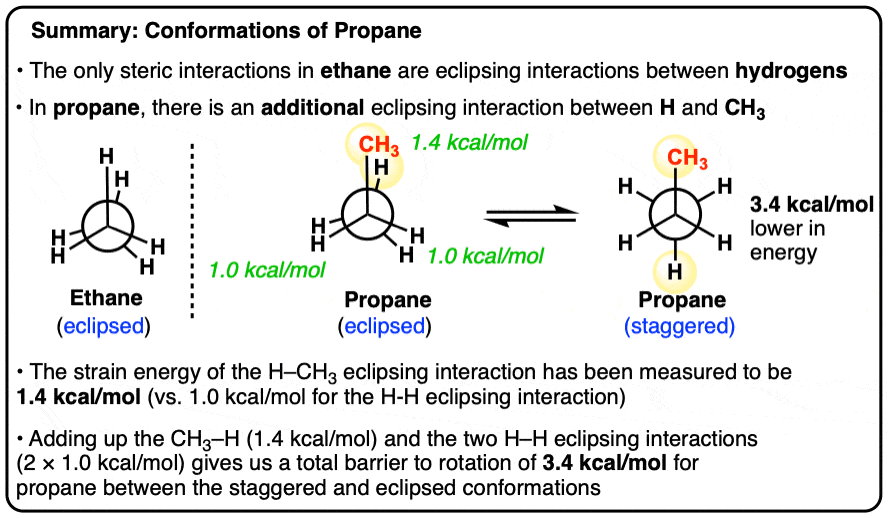
Table of Contents
- Recap: Staggered, Eclipsed, Newman Projections, Dihedral Angle.
- What About Propane?
- Converting Propane to Newman Projections
- The Role of Perspective: Analyze One Bond At A Time
- Eclipsing Interactions in Propane
- Visualizing The Rotational Barrier In Propane
- Summary
- Notes
- Quiz Yourself!
- (Advanced) References and Further Reading
1. Recap: Staggered, Eclipsed, Newman Projections, Dihedral Angle
In the previous post [see: Staggered vs Eclipsed Conformations of Ethane] we saw that ethane has two important conformational isomers, depending on the orientation of the two methyl groups along the C–C bond.
- In the eclipsed conformation, the hydrogens on the front carbon block (or “eclipse”) the hydrogens on the back carbon when one looks directly along the C-C bond, like two Mercedes-Benz symbols superimposed on top of each other.
- In the staggered conformation, the hydrogens on the front carbon bisect the hydrogens on the back carbon, so that if one looks along the C–C bond, the hydrogens are all spaced out by 60 degrees.
- We saw that the Newman projection is a useful visual aid for visualizing the eclipsed and staggered conformations, as well as bond rotations.
- We also defined the dihedral angle as the angle between an arbitrarily chosen individual substituent on the front carbon and an individual substituent on the back carbon when looking along a carbon-carbon bond. A useful analogy for dihedral angle is the angle between the hour hand and minute hand on a clock face, where the dihedral angle is 0° at 12:00, 60° at 2:00, 120° at 4:00, and so on.
- When two substituents have a dihedral angle of –90° ≤ 0° ≤+90 they are syn. When they have a dihedral angle of +90° ≤ 180° ≤ –90° they are anti
- Conformational isomers can differ in energy; in ethane the staggered conformation is more stable than the eclipsed conformation by 3.0 kcal/mol which works out to about 1.0 kcal/mol per eclipsed H-H interaction. One way to think about this is repulsions between the hydrogens (or their electron clouds, to be more specific). There are other ways to think about it too.
2. The Conformational Isomers Of Propane
Now that we’ve looked at ethane, let’s go to the next higher alkane: propane.
Propane is simple to draw as a line diagram. Just like stick figures of people omit granular details like fingers and toes, line diagrams of molecules omit the placement of hydrogens.
Most of the time that’s OK, but if we’re going to discuss conformations, we need to expand out our line diagram of propane to show where the hydrogens are.
Obviously, the first order of business is to make sure that the hydrogens are arranged in a properly tetrahedral fashion around each carbon. (Yes, it’s possible to mess this up, as Khan Academy sometimes does [see post: Common Mistakes: Drawing Tetrahedral Carbons] )
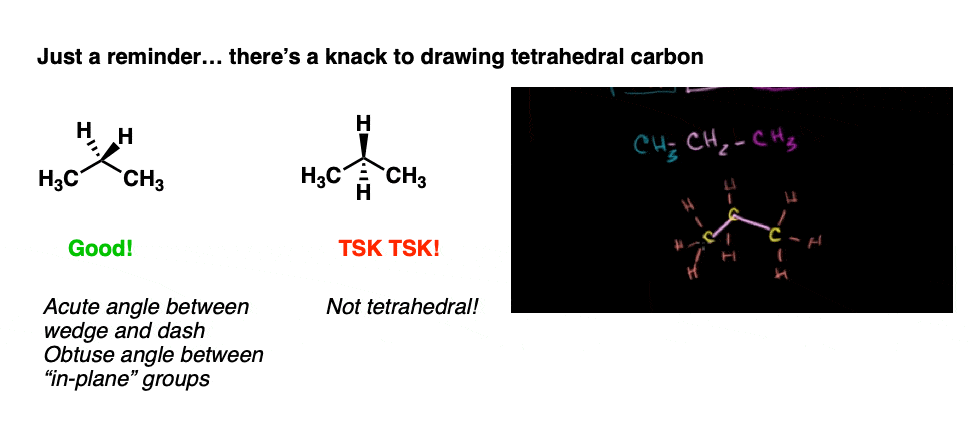
Keep two substituents in the plane of the page, with one wedge and one dash, and an acute angle (<90°) between the wedge and dash.
Here’s a drawing of propane showing all the hydrogens. I’ve arbitrarily numbered the carbon on the left as C-1.
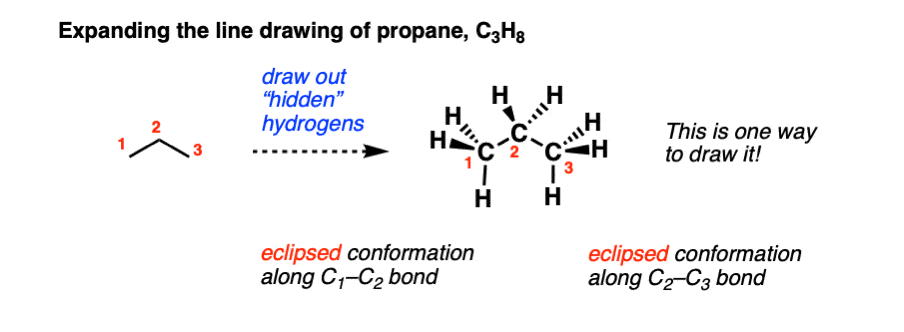
In expanding out the hydrogens on each carbon we now encounter the pesky details of conformational isomerism!
In the figure above, when I expanded out propane, I chose to draw an eclipsed conformation along both the C1-C2 and C2-C3 bonds. That’s one way to do it, and it’s not wrong (even if it is higher in energy).
However, there are other ways to draw out propane as well. I just as well could have drawn the C1-C2 carbon as staggered and the C2-C3 as eclipsed (below) or C1-C2 and C2-C3 as both staggered.
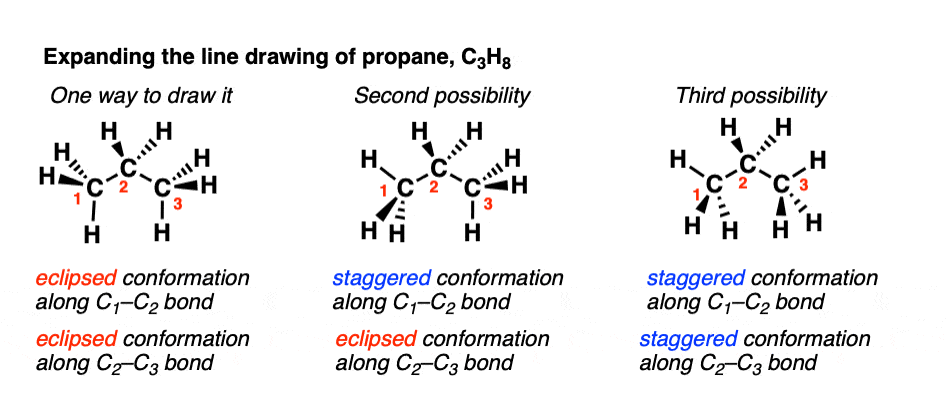
(There are of course other conformations that could be drawn out – an infinite number, but since they aren’t energy minima or maxima they generally aren’t as interesting to us. There are 3600 seconds in an hour, but when was the last time someone asked to meet you at 7:46:23 instead of just “8 o’clock” ?)
It doesn’t really matter too much what conformation we depict propane in. Since there is free rotation about the C1-C2 and C2-C3 bonds, all the conformations are interconvertible.
In propane, the lowest-energy conformation is the one where all the carbons are staggered relative to each other (top right).
That said: is there an easier, more intuitive way to analyze these conformations? Yes!
3. Converting Propane to Newman Projections
The best way to analyze the orientation along a carbon-carbon bond is by using a Newman projection.
The first step in drawing a Newman is to choose a perspective.
In our first drawing of propane, let’s choose to look along the C1-C2 bond, like this:

How did we get this Newman projection? By looking along the C1-C2 bond, like this:
4. The Role of Perspective: Analyze One Bond At A Time
Ultimately, a Newman projection is just a perspective drawing of a three-dimensional object; a molecule.
While artists and photographers have to put a lot of thought into choosing the right perspective for drawing people or buildings, our task is much easier because for the Newman projection, we must look directly along a bond.
Below, I’ve drawn propane such that there is an eclipsed conformation along the C1-C2 bond and a staggered conformation along the C2-C3 bond.
When drawing a Newman, we need to specify which bond we are looking along, and in what direction.
That’s because in even a simple molecule like propane, there are 4 different ways we could look along C-C bonds, and therefore 4 different Newman projections just for this one conformation!
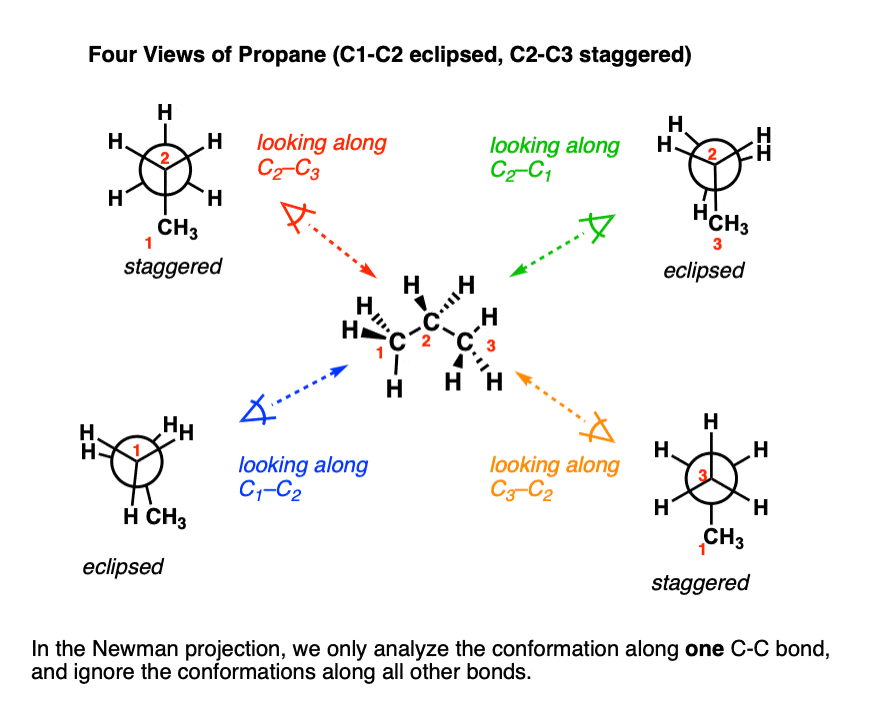
None of these perspectives are “wrong”, just like there is no “wrong” perspective for drawing a house. But each perspective reveals different facets of the molecule’s conformation.
The important thing to note is that we analyze one carbon-carbon bond at a time and ignore the conformations along the other bonds.
So in the Newman projection for looking along C1-C2, we just draw C3 as “CH3” regardless of whether it’s eclipsed or staggered with respect to C2.
When we draw the Newman for looking along C2-C3, ,we draw C1 as “CH3“, no matter what. One bond at a time.
[Breaking down a big problem into a lot of tiny problems, solving them in isolation, and then building them back up to get the big picture (“reductionism”) is a powerful problem-solving technique in organic chemistry. By analyzing the conformations in a tiny molecule like propane, we can then apply what we’ve learned to much bigger molecules. [Note 1] ]
5. Eclipsing Interactions in Propane
In the previous post, we analyzed the conformations of ethane and saw that the eclipsed conformation of ethane was about 3.0 kcal/mol higher in energy than the staggered conformation.
That breaks down to an H-H eclipsing interaction as being worth about 1.0 kcal/mol.
The rotational barrier for propane has also been measured. [Ref] It is 3.4 kcal/mol.
Why might the rotational barrier for propane be higher? This is where looking at the Newman really helps.
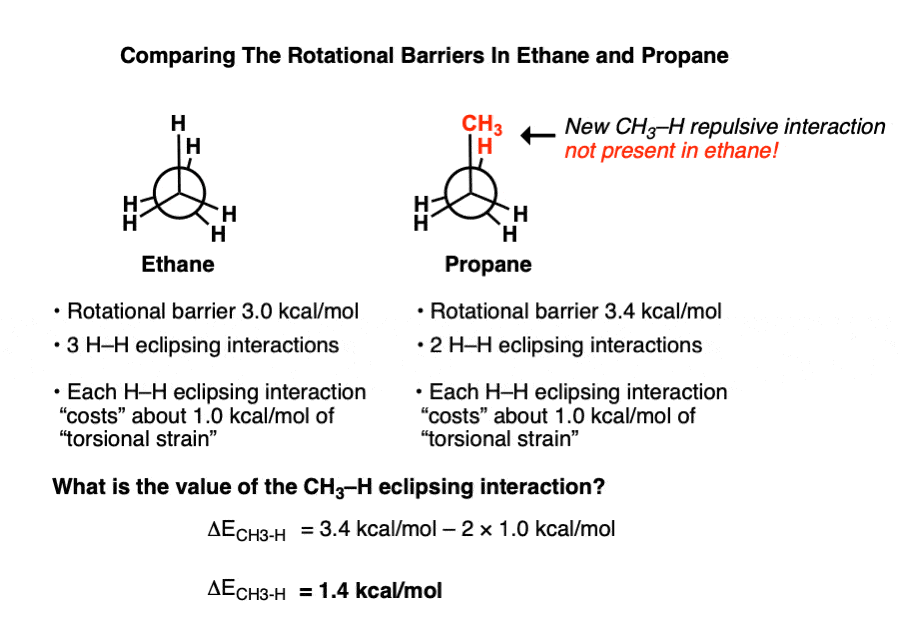
In propane there is a CH3-H repulsive interaction that is not present in ethane.
What’s happening here is that the CH3 group is in relatively close proximity to the C-H bond, and the electron clouds around each group repel each other. This is known as Van der Waals repulsion.
Since CH3 is bigger than H, we would expect this repulsive interaction to be much larger.
But how much larger?
If we assume that each of the two H-H eclipsing interactions in propane is worth 1.0 kcal/mol, this gives the value of the CH3-H eclipsing interaction as “costing” 1.4 kcal/mol in strain energy.
(this is the value of reductionism, by the way: we can use the value of 1.0 kcal/mol per H-H eclipsing interaction we got from ethane and apply it to bigger molecules with H-H eclipsing interactions).
It turns out that this value of 1.4 kcal/mol for eclipsing CH3-H is pretty consistent, as seen in some other molecules (for an application, see Quiz Yourself! below).
6. Visualizing The Rotational Barrier In Propane
Next, let’s have a closer look at the energy profile of the rotational barrier in propane. We’ll start by looking along the C2-C3 bond of propane in the eclipsed conformation with the C1 methyl group pointing straight up and choose our dihedral angle as the angle between the methyl group and the H directly eclipsed by it. We start at a dihedral angle of 0°. In the video below we mark each of them as red.
Now, we’ll rotate the back carbon (C3) in 60° increments, noting the energies as we go:
Note that the conformations repeat themselves every 120° !
If we’re really keen, we can even graph these energies, which would look something like this.
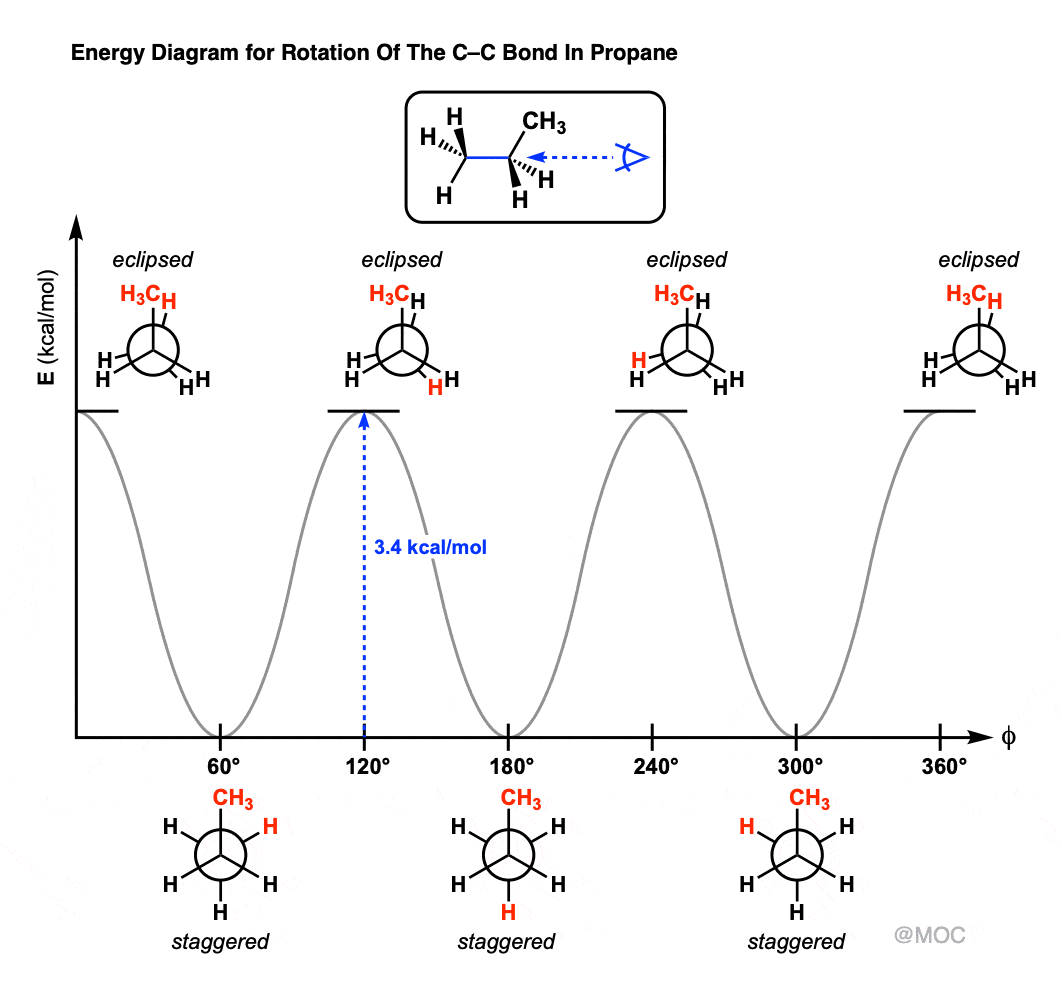
Note that the shape of this graph is exactly the same as what we saw for ethane, except that the rotational barrier is higher.
(It won’t always be so simple, as we’ll see in the next post with butane).
7. Summary: Conformational Isomers of Propane
The analysis for the C2-C3 bond is exactly the same as that for the C1-C2 bond.
Therefore, we now have enough information to calculate the relative stability of the three conformations of propane drawn at the top of the post.
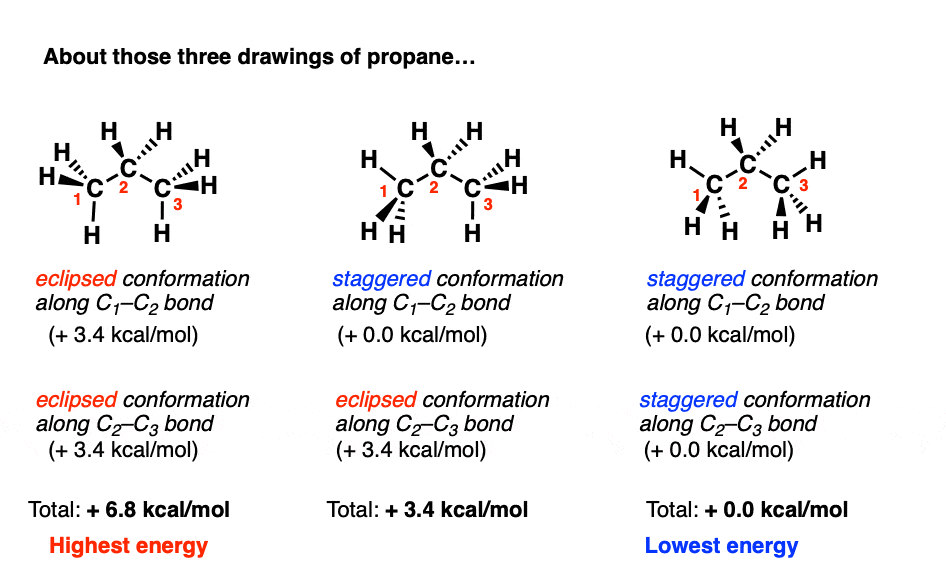
The (staggered, staggered) is lower in energy than the (eclipsed, eclipsed) by about 6.8 kcal/mol.
To summarize:
- The rotational barrier is 3.4 kcal/mol in propane versus 3.0 kcal/mol in ethane. That’s due to the 1.4 kcal/mol CH3-H eclipsing interaction. Since CH3 is bigger in size than H, we should expect to see greater van Der Waals repulsion when the groups are held closely together, such as when they are syn.
- There are multiple perspectives one can choose when drawing a Newman projection.
- When drawing a Newman projection, we focus on the conformation of one C-C bond at a time, and ignore all the other conformations.
- The rotational energy diagram of propane is a sine wave with three maxima, just like ethane.
Pretty straightforward, hopefully. But this is just a warm-up for the main act.
In the next post, we’ll look at the conformations of butane, which has two new types of steric interactions we haven’t seen before!
Notes
Related Articles
Note 1. Conformations are incredibly important in nature – the three-dimensional shape of proteins, to give one example, is affected by the rotation of hundreds or thousands of bonds, and figuring out the energies of these conformations helps us design better therapeutics. Important advances on how to calculate these energies was the basis for the 2013 Nobel Prize in Chemistry.
Thanks to Jeremy Tran for assistance with the rotational energy diagram.
Quiz Yourself!
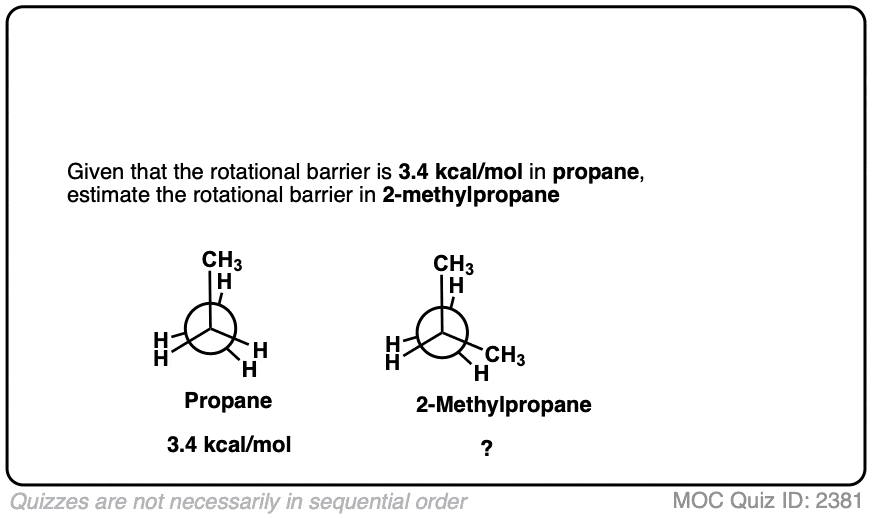 Click to Flip
Click to Flip
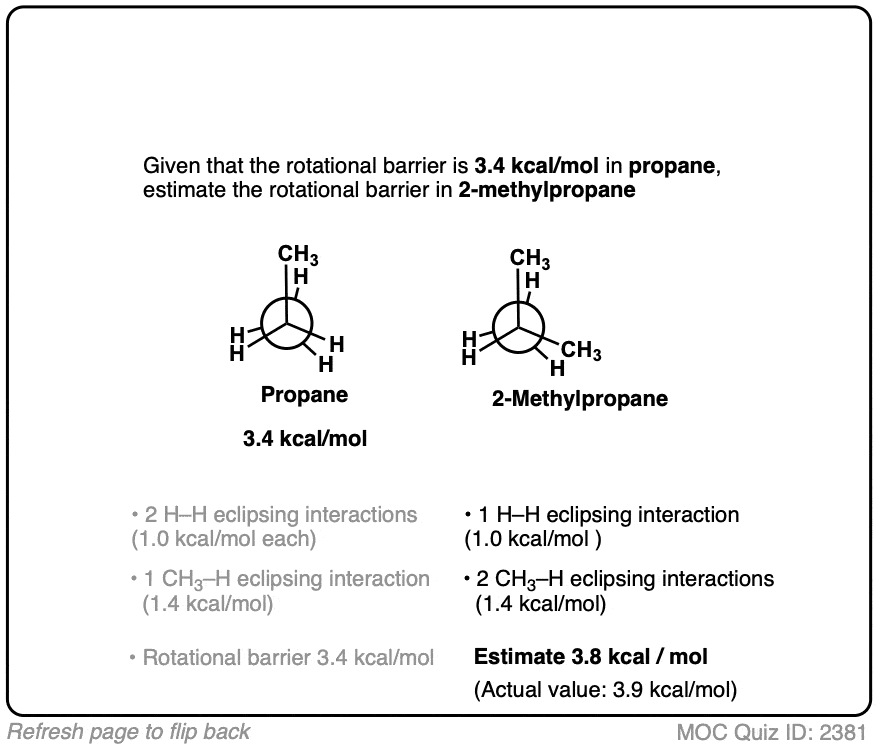
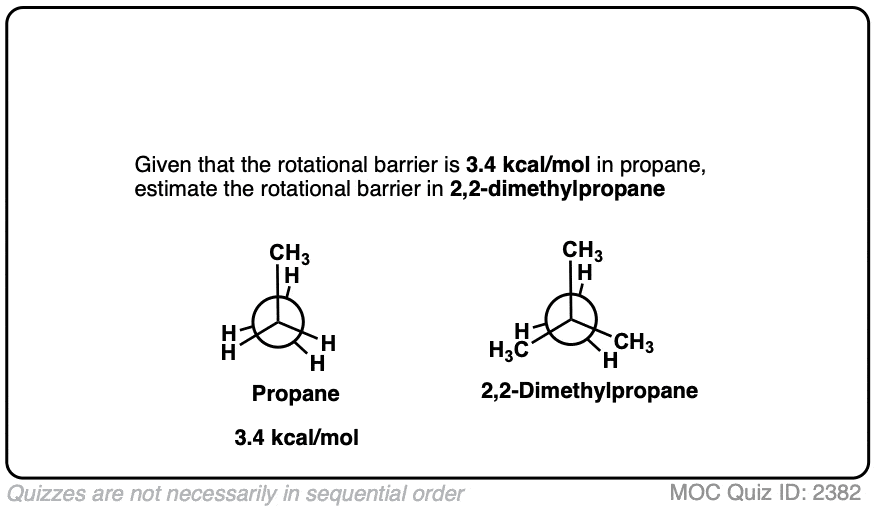 Click to Flip
Click to Flip
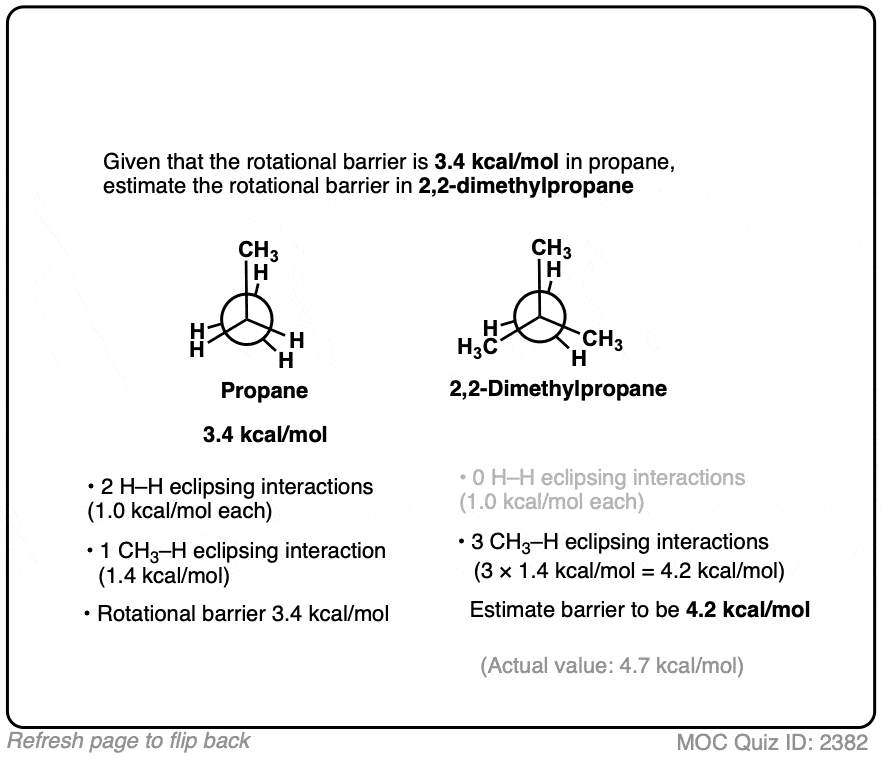
(Advanced) References and Further Reading
- Barriers To Internal Rotation About Single Bonds
John P. Lowe
Progress in Physical Organic Chemistry (eds A. Streitwieser and R.W. Taft).1969, vol. 6.
DOI: 10.1002/9780470171851.ch1
This book chapter compiles studies from many sources on barriers to internal rotation in small molecules such as propane. - Low‐Frequency Modes in Molecular Crystals. IX. Methyl Torsions and Barriers to Internal Rotation of Some Three‐Top Molecules
J. R. Durig, S. M. Craven, and J. Bragin
The Journal of Chemical Physics 53:1, 38-50 1970
DOI: 10.1063/1.1673792
Very technical, but has a calculation of the rotational barrier to 2-methylpropane at 3.94 kcal/mol.
00 General Chemistry Review
01 Bonding, Structure, and Resonance
- How Do We Know Methane (CH4) Is Tetrahedral?
- Hybrid Orbitals and Hybridization
- How To Determine Hybridization: A Shortcut
- Orbital Hybridization And Bond Strengths
- Sigma bonds come in six varieties: Pi bonds come in one
- A Key Skill: How to Calculate Formal Charge
- The Four Intermolecular Forces and How They Affect Boiling Points
- 3 Trends That Affect Boiling Points
- How To Use Electronegativity To Determine Electron Density (and why NOT to trust formal charge)
- Introduction to Resonance
- How To Use Curved Arrows To Interchange Resonance Forms
- Evaluating Resonance Forms (1) - The Rule of Least Charges
- How To Find The Best Resonance Structure By Applying Electronegativity
- Evaluating Resonance Structures With Negative Charges
- Evaluating Resonance Structures With Positive Charge
- Exploring Resonance: Pi-Donation
- Exploring Resonance: Pi-acceptors
- In Summary: Evaluating Resonance Structures
- Drawing Resonance Structures: 3 Common Mistakes To Avoid
- How to apply electronegativity and resonance to understand reactivity
- Bond Hybridization Practice
- Structure and Bonding Practice Quizzes
- Resonance Structures Practice
02 Acid Base Reactions
- Introduction to Acid-Base Reactions
- Acid Base Reactions In Organic Chemistry
- The Stronger The Acid, The Weaker The Conjugate Base
- Walkthrough of Acid-Base Reactions (3) - Acidity Trends
- Five Key Factors That Influence Acidity
- Acid-Base Reactions: Introducing Ka and pKa
- How to Use a pKa Table
- The pKa Table Is Your Friend
- A Handy Rule of Thumb for Acid-Base Reactions
- Acid Base Reactions Are Fast
- pKa Values Span 60 Orders Of Magnitude
- How Protonation and Deprotonation Affect Reactivity
- Acid Base Practice Problems
03 Alkanes and Nomenclature
- Meet the (Most Important) Functional Groups
- Condensed Formulas: Deciphering What the Brackets Mean
- Hidden Hydrogens, Hidden Lone Pairs, Hidden Counterions
- Don't Be Futyl, Learn The Butyls
- Primary, Secondary, Tertiary, Quaternary In Organic Chemistry
- Branching, and Its Affect On Melting and Boiling Points
- The Many, Many Ways of Drawing Butane
- Wedge And Dash Convention For Tetrahedral Carbon
- Common Mistakes in Organic Chemistry: Pentavalent Carbon
- Table of Functional Group Priorities for Nomenclature
- Summary Sheet - Alkane Nomenclature
- Organic Chemistry IUPAC Nomenclature Demystified With A Simple Puzzle Piece Approach
- Boiling Point Quizzes
- Organic Chemistry Nomenclature Quizzes
04 Conformations and Cycloalkanes
- Staggered vs Eclipsed Conformations of Ethane
- Conformational Isomers of Propane
- Newman Projection of Butane (and Gauche Conformation)
- Introduction to Cycloalkanes
- Geometric Isomers In Small Rings: Cis And Trans Cycloalkanes
- Calculation of Ring Strain In Cycloalkanes
- Cycloalkanes - Ring Strain In Cyclopropane And Cyclobutane
- Cyclohexane Conformations
- Cyclohexane Chair Conformation: An Aerial Tour
- How To Draw The Cyclohexane Chair Conformation
- The Cyclohexane Chair Flip
- The Cyclohexane Chair Flip - Energy Diagram
- Substituted Cyclohexanes - Axial vs Equatorial
- Ranking The Bulkiness Of Substituents On Cyclohexanes: "A-Values"
- Cyclohexane Chair Conformation Stability: Which One Is Lower Energy?
- Fused Rings - Cis-Decalin and Trans-Decalin
- Naming Bicyclic Compounds - Fused, Bridged, and Spiro
- Bredt's Rule (And Summary of Cycloalkanes)
- Newman Projection Practice
- Cycloalkanes Practice Problems
05 A Primer On Organic Reactions
- The Most Important Question To Ask When Learning a New Reaction
- Curved Arrows (for reactions)
- Nucleophiles and Electrophiles
- The Three Classes of Nucleophiles
- Nucleophilicity vs. Basicity
- What Makes A Good Nucleophile?
- What Makes A Good Leaving Group?
- 3 Factors That Stabilize Carbocations
- Equilibrium and Energy Relationships
- 7 Factors that stabilize negative charge in organic chemistry
- 7 Factors That Stabilize Positive Charge in Organic Chemistry
- What's a Transition State?
- Hammond's Postulate
- Learning Organic Chemistry Reactions: A Checklist (PDF)
- Introduction to Oxidative Cleavage Reactions
06 Free Radical Reactions
- Bond Dissociation Energies = Homolytic Cleavage
- Free Radical Reactions
- 3 Factors That Stabilize Free Radicals
- What Factors Destabilize Free Radicals?
- Bond Strengths And Radical Stability
- Free Radical Initiation: Why Is "Light" Or "Heat" Required?
- Initiation, Propagation, Termination
- Monochlorination Products Of Propane, Pentane, And Other Alkanes
- Selectivity In Free Radical Reactions
- Selectivity in Free Radical Reactions: Bromination vs. Chlorination
- Halogenation At Tiffany's
- Allylic Bromination
- Bonus Topic: Allylic Rearrangements
- In Summary: Free Radicals
- Synthesis (2) - Reactions of Alkanes
- Free Radicals Practice Quizzes
07 Stereochemistry and Chirality
- Types of Isomers: Constitutional Isomers, Stereoisomers, Enantiomers, and Diastereomers
- How To Draw The Enantiomer Of A Chiral Molecule
- How To Draw A Bond Rotation
- Introduction to Assigning (R) and (S): The Cahn-Ingold-Prelog Rules
- Assigning Cahn-Ingold-Prelog (CIP) Priorities (2) - The Method of Dots
- Enantiomers vs Diastereomers vs The Same? Two Methods For Solving Problems
- Assigning R/S To Newman Projections (And Converting Newman To Line Diagrams)
- How To Determine R and S Configurations On A Fischer Projection
- The Meso Trap
- Optical Rotation, Optical Activity, and Specific Rotation
- Optical Purity and Enantiomeric Excess
- What's a Racemic Mixture?
- Chiral Allenes And Chiral Axes
- Stereochemistry Practice Problems and Quizzes
08 Substitution Reactions
- Nucleophilic Substitution Reactions - Introduction
- Two Types of Nucleophilic Substitution Reactions
- The SN2 Mechanism
- Why the SN2 Reaction Is Powerful
- The SN1 Mechanism
- The Conjugate Acid Is A Better Leaving Group
- Comparing the SN1 and SN2 Reactions
- Polar Protic? Polar Aprotic? Nonpolar? All About Solvents
- Steric Hindrance is Like a Fat Goalie
- Common Blind Spot: Intramolecular Reactions
- Substitution Practice - SN1
- Substitution Practice - SN2
09 Elimination Reactions
- Elimination Reactions (1): Introduction And The Key Pattern
- Elimination Reactions (2): The Zaitsev Rule
- Elimination Reactions Are Favored By Heat
- Two Elimination Reaction Patterns
- The E1 Reaction
- The E2 Mechanism
- E1 vs E2: Comparing the E1 and E2 Reactions
- Antiperiplanar Relationships: The E2 Reaction and Cyclohexane Rings
- Bulky Bases in Elimination Reactions
- Comparing the E1 vs SN1 Reactions
- Elimination (E1) Reactions With Rearrangements
- E1cB - Elimination (Unimolecular) Conjugate Base
- Elimination (E1) Practice Problems And Solutions
- Elimination (E2) Practice Problems and Solutions
10 Rearrangements
11 SN1/SN2/E1/E2 Decision
- Identifying Where Substitution and Elimination Reactions Happen
- Deciding SN1/SN2/E1/E2 (1) - The Substrate
- Deciding SN1/SN2/E1/E2 (2) - The Nucleophile/Base
- SN1 vs E1 and SN2 vs E2 : The Temperature
- Deciding SN1/SN2/E1/E2 - The Solvent
- Wrapup: The Key Factors For Determining SN1/SN2/E1/E2
- Alkyl Halide Reaction Map And Summary
- SN1 SN2 E1 E2 Practice Problems
12 Alkene Reactions
- E and Z Notation For Alkenes (+ Cis/Trans)
- Alkene Stability
- Alkene Addition Reactions: "Regioselectivity" and "Stereoselectivity" (Syn/Anti)
- Stereoselective and Stereospecific Reactions
- Hydrohalogenation of Alkenes and Markovnikov's Rule
- Hydration of Alkenes With Aqueous Acid
- Rearrangements in Alkene Addition Reactions
- Halogenation of Alkenes and Halohydrin Formation
- Oxymercuration Demercuration of Alkenes
- Hydroboration Oxidation of Alkenes
- m-CPBA (meta-chloroperoxybenzoic acid)
- OsO4 (Osmium Tetroxide) for Dihydroxylation of Alkenes
- Palladium on Carbon (Pd/C) for Catalytic Hydrogenation of Alkenes
- Cyclopropanation of Alkenes
- A Fourth Alkene Addition Pattern - Free Radical Addition
- Alkene Reactions: Ozonolysis
- Summary: Three Key Families Of Alkene Reaction Mechanisms
- Synthesis (4) - Alkene Reaction Map, Including Alkyl Halide Reactions
- Alkene Reactions Practice Problems
13 Alkyne Reactions
- Acetylides from Alkynes, And Substitution Reactions of Acetylides
- Partial Reduction of Alkynes With Lindlar's Catalyst
- Partial Reduction of Alkynes With Na/NH3 To Obtain Trans Alkenes
- Alkyne Hydroboration With "R2BH"
- Hydration and Oxymercuration of Alkynes
- Hydrohalogenation of Alkynes
- Alkyne Halogenation: Bromination, Chlorination, and Iodination of Alkynes
- Alkyne Reactions - The "Concerted" Pathway
- Alkenes To Alkynes Via Halogenation And Elimination Reactions
- Alkynes Are A Blank Canvas
- Synthesis (5) - Reactions of Alkynes
- Alkyne Reactions Practice Problems With Answers
14 Alcohols, Epoxides and Ethers
- Alcohols - Nomenclature and Properties
- Alcohols Can Act As Acids Or Bases (And Why It Matters)
- Alcohols - Acidity and Basicity
- The Williamson Ether Synthesis
- Ethers From Alkenes, Tertiary Alkyl Halides and Alkoxymercuration
- Alcohols To Ethers via Acid Catalysis
- Cleavage Of Ethers With Acid
- Epoxides - The Outlier Of The Ether Family
- Opening of Epoxides With Acid
- Epoxide Ring Opening With Base
- Making Alkyl Halides From Alcohols
- Tosylates And Mesylates
- PBr3 and SOCl2
- Elimination Reactions of Alcohols
- Elimination of Alcohols To Alkenes With POCl3
- Alcohol Oxidation: "Strong" and "Weak" Oxidants
- Demystifying The Mechanisms of Alcohol Oxidations
- Protecting Groups For Alcohols
- Thiols And Thioethers
- Calculating the oxidation state of a carbon
- Oxidation and Reduction in Organic Chemistry
- Oxidation Ladders
- SOCl2 Mechanism For Alcohols To Alkyl Halides: SN2 versus SNi
- Alcohol Reactions Roadmap (PDF)
- Alcohol Reaction Practice Problems
- Epoxide Reaction Quizzes
- Oxidation and Reduction Practice Quizzes
15 Organometallics
- What's An Organometallic?
- Formation of Grignard and Organolithium Reagents
- Organometallics Are Strong Bases
- Reactions of Grignard Reagents
- Protecting Groups In Grignard Reactions
- Synthesis Problems Involving Grignard Reagents
- Grignard Reactions And Synthesis (2)
- Organocuprates (Gilman Reagents): How They're Made
- Gilman Reagents (Organocuprates): What They're Used For
- The Heck, Suzuki, and Olefin Metathesis Reactions (And Why They Don't Belong In Most Introductory Organic Chemistry Courses)
- Reaction Map: Reactions of Organometallics
- Grignard Practice Problems
16 Spectroscopy
- Degrees of Unsaturation (or IHD, Index of Hydrogen Deficiency)
- Conjugation And Color (+ How Bleach Works)
- Introduction To UV-Vis Spectroscopy
- UV-Vis Spectroscopy: Absorbance of Carbonyls
- UV-Vis Spectroscopy: Practice Questions
- Bond Vibrations, Infrared Spectroscopy, and the "Ball and Spring" Model
- Infrared Spectroscopy: A Quick Primer On Interpreting Spectra
- IR Spectroscopy: 4 Practice Problems
- 1H NMR: How Many Signals?
- Homotopic, Enantiotopic, Diastereotopic
- Diastereotopic Protons in 1H NMR Spectroscopy: Examples
- 13-C NMR - How Many Signals
- Liquid Gold: Pheromones In Doe Urine
- Natural Product Isolation (1) - Extraction
- Natural Product Isolation (2) - Purification Techniques, An Overview
- Structure Determination Case Study: Deer Tarsal Gland Pheromone
17 Dienes and MO Theory
- What To Expect In Organic Chemistry 2
- Are these molecules conjugated?
- Conjugation And Resonance In Organic Chemistry
- Bonding And Antibonding Pi Orbitals
- Molecular Orbitals of The Allyl Cation, Allyl Radical, and Allyl Anion
- Pi Molecular Orbitals of Butadiene
- Reactions of Dienes: 1,2 and 1,4 Addition
- Thermodynamic and Kinetic Products
- More On 1,2 and 1,4 Additions To Dienes
- s-cis and s-trans
- The Diels-Alder Reaction
- Cyclic Dienes and Dienophiles in the Diels-Alder Reaction
- Stereochemistry of the Diels-Alder Reaction
- Exo vs Endo Products In The Diels Alder: How To Tell Them Apart
- HOMO and LUMO In the Diels Alder Reaction
- Why Are Endo vs Exo Products Favored in the Diels-Alder Reaction?
- Diels-Alder Reaction: Kinetic and Thermodynamic Control
- The Retro Diels-Alder Reaction
- The Intramolecular Diels Alder Reaction
- Regiochemistry In The Diels-Alder Reaction
- The Cope and Claisen Rearrangements
- Electrocyclic Reactions
- Electrocyclic Ring Opening And Closure (2) - Six (or Eight) Pi Electrons
- Diels Alder Practice Problems
- Molecular Orbital Theory Practice
18 Aromaticity
- Introduction To Aromaticity
- Rules For Aromaticity
- Huckel's Rule: What Does 4n+2 Mean?
- Aromatic, Non-Aromatic, or Antiaromatic? Some Practice Problems
- Antiaromatic Compounds and Antiaromaticity
- The Pi Molecular Orbitals of Benzene
- The Pi Molecular Orbitals of Cyclobutadiene
- Frost Circles
- Aromaticity Practice Quizzes
19 Reactions of Aromatic Molecules
- Electrophilic Aromatic Substitution: Introduction
- Activating and Deactivating Groups In Electrophilic Aromatic Substitution
- Electrophilic Aromatic Substitution - The Mechanism
- Ortho-, Para- and Meta- Directors in Electrophilic Aromatic Substitution
- Understanding Ortho, Para, and Meta Directors
- Why are halogens ortho- para- directors?
- Disubstituted Benzenes: The Strongest Electron-Donor "Wins"
- Electrophilic Aromatic Substitutions (1) - Halogenation of Benzene
- Electrophilic Aromatic Substitutions (2) - Nitration and Sulfonation
- EAS Reactions (3) - Friedel-Crafts Acylation and Friedel-Crafts Alkylation
- Intramolecular Friedel-Crafts Reactions
- Nucleophilic Aromatic Substitution (NAS)
- Nucleophilic Aromatic Substitution (2) - The Benzyne Mechanism
- Reactions on the "Benzylic" Carbon: Bromination And Oxidation
- The Wolff-Kishner, Clemmensen, And Other Carbonyl Reductions
- More Reactions on the Aromatic Sidechain: Reduction of Nitro Groups and the Baeyer Villiger
- Aromatic Synthesis (1) - "Order Of Operations"
- Synthesis of Benzene Derivatives (2) - Polarity Reversal
- Aromatic Synthesis (3) - Sulfonyl Blocking Groups
- Birch Reduction
- Synthesis (7): Reaction Map of Benzene and Related Aromatic Compounds
- Aromatic Reactions and Synthesis Practice
- Electrophilic Aromatic Substitution Practice Problems
20 Aldehydes and Ketones
- What's The Alpha Carbon In Carbonyl Compounds?
- Nucleophilic Addition To Carbonyls
- Aldehydes and Ketones: 14 Reactions With The Same Mechanism
- Sodium Borohydride (NaBH4) Reduction of Aldehydes and Ketones
- Grignard Reagents For Addition To Aldehydes and Ketones
- Wittig Reaction
- Hydrates, Hemiacetals, and Acetals
- Imines - Properties, Formation, Reactions, and Mechanisms
- All About Enamines
- Breaking Down Carbonyl Reaction Mechanisms: Reactions of Anionic Nucleophiles (Part 2)
- Aldehydes Ketones Reaction Practice
21 Carboxylic Acid Derivatives
- Nucleophilic Acyl Substitution (With Negatively Charged Nucleophiles)
- Addition-Elimination Mechanisms With Neutral Nucleophiles (Including Acid Catalysis)
- Basic Hydrolysis of Esters - Saponification
- Transesterification
- Proton Transfer
- Fischer Esterification - Carboxylic Acid to Ester Under Acidic Conditions
- Lithium Aluminum Hydride (LiAlH4) For Reduction of Carboxylic Acid Derivatives
- LiAlH[Ot-Bu]3 For The Reduction of Acid Halides To Aldehydes
- Di-isobutyl Aluminum Hydride (DIBAL) For The Partial Reduction of Esters and Nitriles
- Amide Hydrolysis
- Thionyl Chloride (SOCl2)
- Diazomethane (CH2N2)
- Carbonyl Chemistry: Learn Six Mechanisms For the Price Of One
- Making Music With Mechanisms (PADPED)
- Carboxylic Acid Derivatives Practice Questions
22 Enols and Enolates
- Keto-Enol Tautomerism
- Enolates - Formation, Stability, and Simple Reactions
- Kinetic Versus Thermodynamic Enolates
- Aldol Addition and Condensation Reactions
- Reactions of Enols - Acid-Catalyzed Aldol, Halogenation, and Mannich Reactions
- Claisen Condensation and Dieckmann Condensation
- Decarboxylation
- The Malonic Ester and Acetoacetic Ester Synthesis
- The Michael Addition Reaction and Conjugate Addition
- The Robinson Annulation
- Haloform Reaction
- The Hell–Volhard–Zelinsky Reaction
- Enols and Enolates Practice Quizzes
23 Amines
- The Amide Functional Group: Properties, Synthesis, and Nomenclature
- Basicity of Amines And pKaH
- 5 Key Basicity Trends of Amines
- The Mesomeric Effect And Aromatic Amines
- Nucleophilicity of Amines
- Alkylation of Amines (Sucks!)
- Reductive Amination
- The Gabriel Synthesis
- Some Reactions of Azides
- The Hofmann Elimination
- The Hofmann and Curtius Rearrangements
- The Cope Elimination
- Protecting Groups for Amines - Carbamates
- The Strecker Synthesis of Amino Acids
- Introduction to Peptide Synthesis
- Reactions of Diazonium Salts: Sandmeyer and Related Reactions
- Amine Practice Questions
24 Carbohydrates
- D and L Notation For Sugars
- Pyranoses and Furanoses: Ring-Chain Tautomerism In Sugars
- What is Mutarotation?
- Reducing Sugars
- The Big Damn Post Of Carbohydrate-Related Chemistry Definitions
- The Haworth Projection
- Converting a Fischer Projection To A Haworth (And Vice Versa)
- Reactions of Sugars: Glycosylation and Protection
- The Ruff Degradation and Kiliani-Fischer Synthesis
- Isoelectric Points of Amino Acids (and How To Calculate Them)
- Carbohydrates Practice
- Amino Acid Quizzes
25 Fun and Miscellaneous
- A Gallery of Some Interesting Molecules From Nature
- Screw Organic Chemistry, I'm Just Going To Write About Cats
- On Cats, Part 1: Conformations and Configurations
- On Cats, Part 2: Cat Line Diagrams
- On Cats, Part 4: Enantiocats
- On Cats, Part 6: Stereocenters
- Organic Chemistry Is Shit
- The Organic Chemistry Behind "The Pill"
- Maybe they should call them, "Formal Wins" ?
- Why Do Organic Chemists Use Kilocalories?
- The Principle of Least Effort
- Organic Chemistry GIFS - Resonance Forms
- Reproducibility In Organic Chemistry
- What Holds The Nucleus Together?
- How Reactions Are Like Music
- Organic Chemistry and the New MCAT
26 Organic Chemistry Tips and Tricks
- Common Mistakes: Formal Charges Can Mislead
- Partial Charges Give Clues About Electron Flow
- Draw The Ugly Version First
- Organic Chemistry Study Tips: Learn the Trends
- The 8 Types of Arrows In Organic Chemistry, Explained
- Top 10 Skills To Master Before An Organic Chemistry 2 Final
- Common Mistakes with Carbonyls: Carboxylic Acids... Are Acids!
- Planning Organic Synthesis With "Reaction Maps"
- Alkene Addition Pattern #1: The "Carbocation Pathway"
- Alkene Addition Pattern #2: The "Three-Membered Ring" Pathway
- Alkene Addition Pattern #3: The "Concerted" Pathway
- Number Your Carbons!
- The 4 Major Classes of Reactions in Org 1
- How (and why) electrons flow
- Grossman's Rule
- Three Exam Tips
- A 3-Step Method For Thinking Through Synthesis Problems
- Putting It Together
- Putting Diels-Alder Products in Perspective
- The Ups and Downs of Cyclohexanes
- The Most Annoying Exceptions in Org 1 (Part 1)
- The Most Annoying Exceptions in Org 1 (Part 2)
- The Marriage May Be Bad, But the Divorce Still Costs Money
- 9 Nomenclature Conventions To Know
- Nucleophile attacks Electrophile
27 Case Studies of Successful O-Chem Students
- Success Stories: How Corina Got The The "Hard" Professor - And Got An A+ Anyway
- How Helena Aced Organic Chemistry
- From a "Drop" To B+ in Org 2 – How A Hard Working Student Turned It Around
- How Serge Aced Organic Chemistry
- Success Stories: How Zach Aced Organic Chemistry 1
- Success Stories: How Kari Went From C– to B+
- How Esther Bounced Back From a "C" To Get A's In Organic Chemistry 1 And 2
- How Tyrell Got The Highest Grade In Her Organic Chemistry Course
- This Is Why Students Use Flashcards
- Success Stories: How Stu Aced Organic Chemistry
- How John Pulled Up His Organic Chemistry Exam Grades
- Success Stories: How Nathan Aced Organic Chemistry (Without It Taking Over His Life)
- How Chris Aced Org 1 and Org 2
- Interview: How Jay Got an A+ In Organic Chemistry
- How to Do Well in Organic Chemistry: One Student's Advice
- "America's Top TA" Shares His Secrets For Teaching O-Chem
- "Organic Chemistry Is Like..." - A Few Metaphors
- How To Do Well In Organic Chemistry: Advice From A Tutor
- Guest post: "I went from being afraid of tests to actually looking forward to them".
it was very good, well explained and it made my expectations